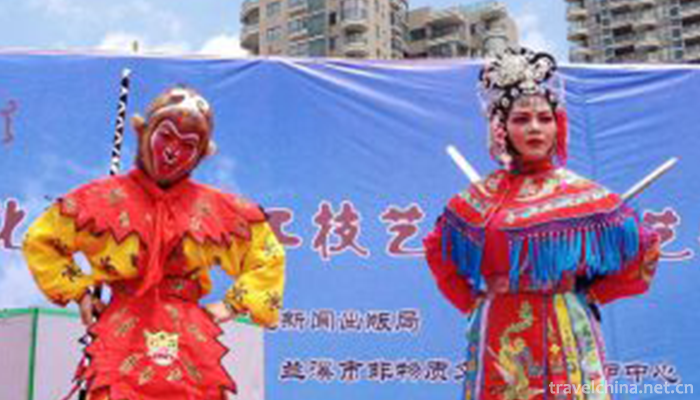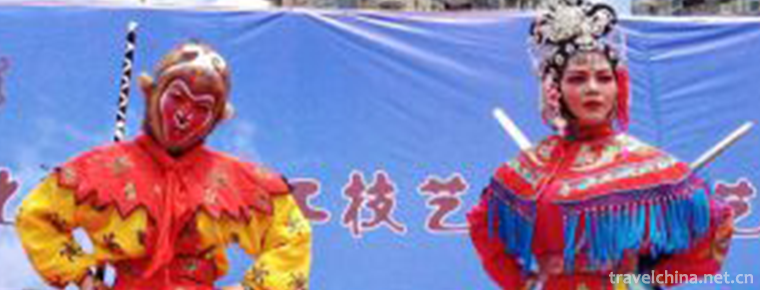Suzhou opera
Suzhou opera
Spring spread (Hangzhou Spring spread, Shaoxing Spring spread), which originated in the mid-Qing Dynasty, belongs to the category of songs.
On June 7, 2008, Hangzhou and Shaoxing City of Zhejiang Province jointly declared "Spring Spring Spring Spring Packing" which was approved by the State Council to be included in the second batch of national intangible cultural heritage list.
historical origin
Local operas were popular in Jiangsu and Zhejiang in Qing Dynasty. Rising in the Qianlong period, it was called Tanhuangdiao, which was originally a sitting and singing form of endorsement. After Daoguang, Kunqu Opera declined gradually and Tanhuang began to transplant Kunqu Folk Opera in sitting form, which was included in Baiqiu. Each fold was divided into four or five sections. Following the Kunqu Opera, it used a simple and complicated voice, singing loud songs like drums, euphemistically like ballads, and dragging tones like Kunqu Opera. It was a popular singing method of Kunqu Opera, known as Qiantan. Another folk song minor singing, with funny repertoire, known as Houtan.
By the end of the Qing Dynasty and the beginning of the Republic of China, small operas had flourished, and Tanhuang in various places had followed the traditional opera form and put on stage in make-up. With the increase of roles and the need of performance, tunes and music have gradually evolved, forming various local operas of Tanhuang Opera System, such as Su Opera, Yong Opera, Xiju Opera, Shanghai Opera, etc.
artistic characteristics
artistic form
Its basic artistic features are singing, talking and singing, and mainly sitting and singing opera with a prominent voice. Traditional repertoire usually consists of five to seven actors, who play the roles of Sheng Sheng, Dan, Jing and Ugly. They play three strings, pipa, Huqin and other instruments, and sing by themselves. One person plays one or more corners and uses simulated expressions and actions to depict characters and narrate stories. "Zhejiang intangible cultural heritage representative works series: Hangzhou Spring Spring" is one of the series of Zhejiang Intangible Cultural Heritage Representative works. It introduces in detail the historical origin, development status, inheritance context and development prospects of Hangzhou Spring Spring Spring Spring as a local folk art.
Epidemic areas
Spring springs are beach springs. A folk art popular in Suzhou, Shanghai, Hangzhou and Ningbo. The stall leads to the beach. Li Dou of the Qing Dynasty wrote "Records of Yangzhou Paintings by Hongqiao": "The first priority is the solo singing, followed by the ten drums, such as gongs and drums, instant collision, ditties, springs, dialogue and commentary, all of which are of great help." See Beach Spring.
Schools
Haining School, commonly known as "Haining Spring Spring Spring". Haining Spring Spring Shopping is a kind of folk music with short and concise form, lively singing and popular among the masses.
Haining Tan-huang is a self-taught and self-singing style of music performance with dialectal slang, band accompaniment and the role of general band performers and singers. The traditional music cards of Haining Spring Shop are "Dongxiang Diao" and "Appreciating Palace Flowers". The traditional songs include "Jade Dragonfly", "Little Nun Down Mountain", "The Story of the Western Chamber" and "Selling Grass and Rattan". Haining Spring Shop is often performed in the ceremony of family wedding, birthday celebration, house building, silkworm rearing, fertility and other traditional festivals, temple fairs and other folk activities. These ceremonies and activities often invite theatres, choirs, Taoist societies, shadow plays and Sao Zi Shu to sing. While performing the original play, Haining Tan-huang has the function of gathering excitement and adjusting the atmosphere along with the interluding of the main events.
As a traditional folk art, Haining Spring Shop absorbs and improves Shanghai Spring Shop, which is widely spread in Dingqiao and Qingyun of Haining. At present, in Dingqiao Town's choir or Taoist team's singing, still interspersed with the singing of Haining Spring, and injected new era content into the singing.
Inheritance Significance
Spring-spreading reflects the entertainment and cultural elements of the masses in a specific era, and has a high value in the study of folk art.


-
1.Sintering Techniques of Cizhou Kiln
Cizhou kiln firing technology, the local traditional firing technology of Fengfeng mining area in Hebei Province, is one of the national intangible cultural heritage.
Time 2019-04-22 -
2.Lantern show
Lantern Opera is not only a traditional folk opera with local characteristics in Chongqing and Sichuan, but also one of the important voices of Sichuan Opera. It originates from northeast Sichuan
Time 2019-04-26 -
3.Dulong Kakuwa Festival
Dulong Kakuwa Festival spreads in all Dulong villages in the Dulong River Valley in the west of Gongshan Dulong Nu Autonomous County, Nujiang Lisu Autonomous Prefecture
Time 2019-04-28 -
4.Multi voice Folk Songs of Hani Nationality
Hani multi-voice folk songs are popular in several Hani villages in the eastern part of Azahe Township, Honghe County, with Puchun Village as the center. Their natural environment is closed and traffi
Time 2019-05-02 -
5.Stories of Marine Animals
Marine animal stories are mainly handed down orally. The traditional folklore stories circulated in the islands for a long time have been formed and disseminated in Dongtou
Time 2019-05-02 -
6.Luonan Jing Blackboard
In 2011, Luonan Jingbanshu was approved by the State Council and listed in the third batch of national intangible cultural heritage list. As early as in the Daoguang period of the Qing Dynasty (around
Time 2019-05-15 -
7.Nuo opera
Nuo Opera originated from Fang Xiangshi's exorcism activities in Shang and Zhou Dynasties. After Han Dynasty, it gradually developed into a ritual ceremony with strong entertaining color and opera mus
Time 2019-06-08 -
8.Pudong Publicity Book
Nanhui Xuanjuan is an ancient traditional art of rap and singing. Xuanjuan originated from "vulgar speaking" in Tang Dynasty and "Tanjing" in Song Dynasty. It is a term used by Bud
Time 2019-06-09 -
9.Tongcheng Song
Tongcheng Song is a kind of local folk song originating from Tongcheng, Anhui Province. It is a kind of local folk literature in the form of rhyme created by the local working people collectively. At
Time 2019-06-21 -
10.Mount Emei Jinding
Mt. Emei Jinding, also known as Huazang temple, is located on the main peak of Emei Mountain in Sichuan Province, China (29.52567 ° n, 103.336802 ° E), with an altitude of 3077 m. It is the end point of Emei Mountain tour and one of the key Buddhist temples in the Han area.
Time 2020-10-15 -
11.Ganzi Zanba
"Zanba" is the Tibetan transliteration of fried noodles. It is a staple food that Tibetan people must eat every day. If you are a guest of Tibetan compatriots' homes, the host will bring you fragrant milk tea and highland barley fried noodles, golden butter and milk yellow "Qula" (casein) and sugar stacked on the table.
Time 2020-12-06 -
12.Sports in Panzhihua
By the end of 2018, Panzhihua had 21 stadiums (gymnasiums), 56 sports social groups at all levels, 694 national fitness routes and 263 social sports guidance stations. The city's various sports teams won 80 gold medals, 91 silver medals and 72 bronze medals in provincial competitions. 124 national fitness activities were held throughout the year, with 460000 participants.
Time 2020-12-14